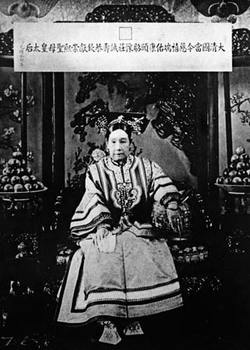 Cixi, c. 1904 Hulton-Deutsch Collection/Corbis (http://www.britannica.com/biography/Cixi) Cixi, c. 1904 Hulton-Deutsch Collection/Corbis (http://www.britannica.com/biography/Cixi) The Empress Dowager Cixi controlled the Qing dynasty for nearly half a century. Despite her long rule, she’s often portrayed as greedy, corrupt and even referred to as the “She Dragon.” While many records describe Cixi as a woman pursuant of power, a usurper and vicious, other recent historical works paint the empress in a different light. For example, Jung Chang credits Cixi with opening China’s doors to the west and for implementing progressive reforms, such as outlawing the painful and crippling tradition of binding Chinese women’s feet. Cixi’s beginning Empress Dowager Cixi was born on Nov. 29, 1835 and bore the name Yehenara. She had an overall normal childhood, though her family was from the ruling Manchu minority. At the age of 14, Cixi was nominated as a candidate-concubine and two years later she was honored when she was selected to be in one of Emperor Xianfeng’s harems. Even though she started in as one of the low-ranking concubines, she became one of the emperor’s frequent requests. However, in 1856, Cixi rose in rank. In this year, Cixi bore the emperor’s only son, Tongzhi, which solidified her value to the emperor and landed her the title, “Cixi” (formerly spelled as “Tzu Hsi”), which means: empress of the western palace. Emperor Xianfeng died in 1861 when Tongzhi, his son with Cixi and heir to the palace, was only five-years old. At this time, Cixi became the “empress dowager,” and a regency ruler along with Ci’an, Xianfeng’s other former senior consort. Cixi’s Rule and Revitalization During Cixi’s rule, along with the leadership and guidance of Gong Qinwang (Prince Gong), the deceased emperor’s brother, China entered into a period of revitalization. Conflicts such the Taiping Rebellion and the Nian Rebellion were put down. “Schools were created for the study of foreign languages, a modern customs service was instituted, Western-style arsenals were constructed, and the first Chinese foreign service office was installed. Internally, an effort was made to end governmental corruption and to recruit men of talent,” according to the Encyclopedia Britannica. Cixi and Scandal In 1873, Cixi’s son, Tongzhi, reached an age old enough to rule and so the regency was terminated. Only three years later, Tongzhi died. Tongzhi had not yet made an heir; however Alute, who was among his highest-ranking concubines, was pregnant. During the debate of succession, Alute died. Many historians are quizzical about the timing of this incident. The New York Times even wrote that the situation “aroused general suspicion” after the Qing Court announced that Alute’s death was a “suicide” in 1875. The emperor’s succession fell to Cixi’s three-year-old nephew, Guangxu, whom she adopted. Cixi and Ci’an again took over the regency until 1881, which is when Ci’an suddenly died, making Cixi the lone ruler of this office and in a position of much power. However, in 1889, Cixi released her control to Guangxu, and said she would retire to a palace she rebuilt in Beijing. The youthful emperor Guangxu attempted to renovate and modernize China’s government after Chinese forces were defeated in the Sino-Japanese War in 1894-95; however, conservatives staged a military coup and placed Cixi back atop the regency as well as reversed the reforms made. Hope for peaceful change dwindled. Furthermore, Cixi supported the Boxer Rebellion, which consequently ended in approximately 100 foreigners killed. Following this, Cixi was forced to accept “humiliating peace terms” and flee from her home in Beijing in 1900. She returned two years later and attempted some of the reforms Guangxu had attempted before the turn of the century. However, suspicion and scandal returned to Cixi. In fact, the death of Guangxu was announced the day before Cixi’s death, and in 2008, a report confirmed what had been suspected for a century: the emperor had been purposefully poisoned. Though it’s unclear who the culprit was in this poisoning, many point to Cixi. Change and Chance Though Cixi’s reputation remains critiqued and soiled with scandal, some historians point to Cixi as a constant encourager of change and reform. Chang writes about Cixi’s advocacy of policies that learned from the west. In 1902, Cixi outlawed the painful and crippling process of footbinding, which was a centuries old tradition that often left women open to infection and disease. According to the History Channel, “Recognizing the way in which foot binding constricted a woman's freedom, independence, and power, which she enjoyed in spades, Cixi banned the practice on 1 February 1902.” Though the practice was reinstated just 10 years later, after her death, the Republic of China reinstated Cixi’s ban after the fall of the Qing dynasty. Cixi’s legacy is entangled with reputational reports that may or may not be true. “History can be a slippery substance, particularly when it comes to personalities. A century after the death of China's last and most famous empress, Cixi, the story of her life and reign remains veiled by varying versions of the truth,” wrote Amanda Fiegl in the Smithsonian. What we do know is Cixi was a very powerful woman in China during a period of change, conflict and reform for nearly half a century. - Lisa Zimmermann
0 Comments
Your comment will be posted after it is approved.
Leave a Reply. |
Archives
July 2017
Categories
All
|
 RSS Feed
RSS Feed